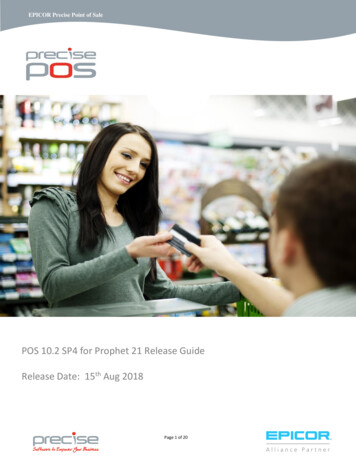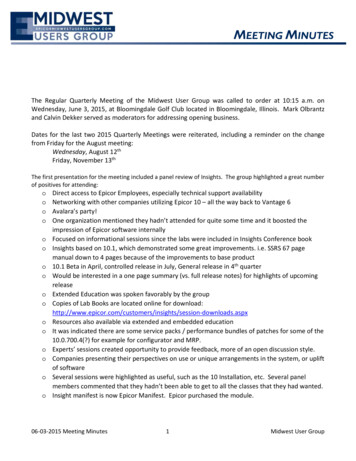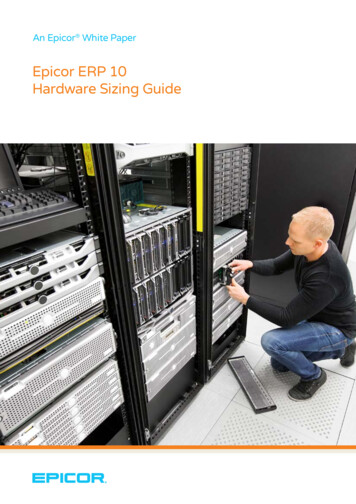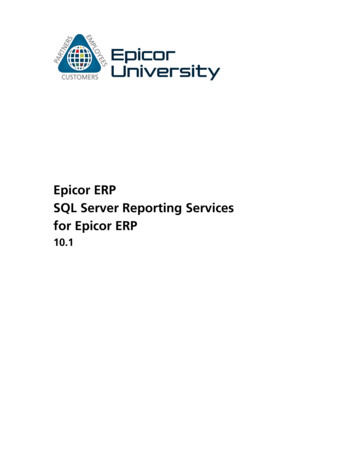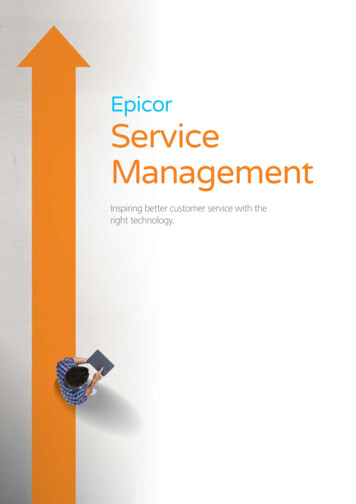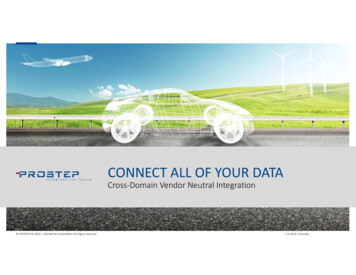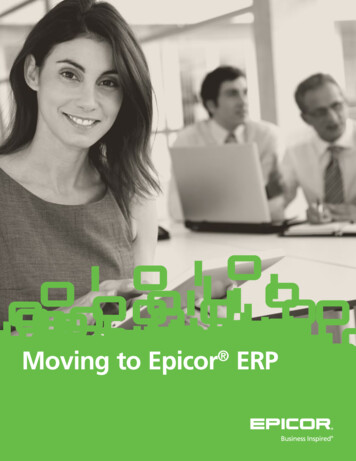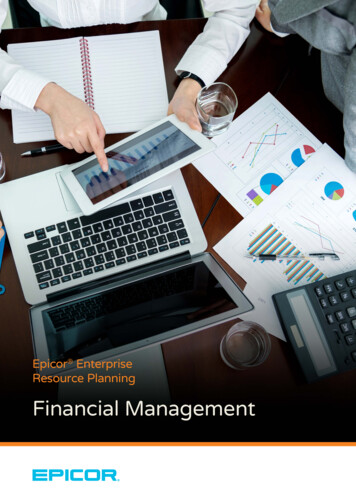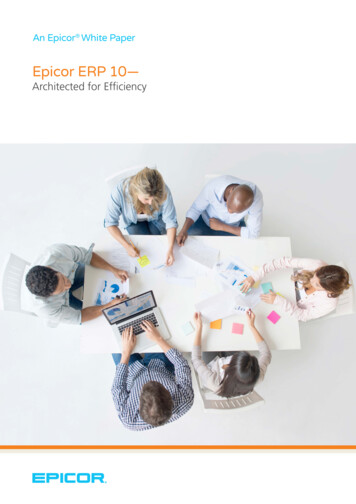
Transcription
An Epicor White PaperEpicor ERP 10—Architected for Efficiency
Epicor ERP 10—Architected for EfficiencyTable of ContentIntroduction.1How Epicor ERP 10 Is Built.2System Architecture.3Performance and Scalability.8System Requirements.10Conclusion: A Foundation for Success.11i
Epicor ERP 10—Architected for EfficiencyIntroductionToday’s global business environment has transformed what enterprises need from their ERPsystems. Global competition has led to the development of extended value networks, withfacilities, suppliers, and partners in every part of the globe; moreover, it is much more nuancedthan was ever imagined. Change is constant. Innovation is accelerating. Competitive pressuresand customer expectations are higher. In this dynamic and challenging environment, technologymust support the goals of better collaboration, increased agility, real-time responsiveness, andhigher performance while reducing complexity in what is inherently a complex structure. Failing todo so may hinder what technology is meant to drive: growth and opportunity.Epicor ERP 10 has been built from the ground up to comprehensively respond to these needsand provide the support organizations require to thrive in today’s competitive global businesslandscape. Guided by the needs of today’s organizations, Epicor ERP 10 streamlines the use ofERP across multiple devices while providing greater deployment choices, reduced complexity, andremarkable ease-of-use. Built on agile technology to provide rich, global functionality, we believeit is a truly inspired ERP solution, one that not only unleashes the full potential of ERP, but alsochanges its role from necessary infrastructure to active facilitator of business growthand sustainability.1
Epicor ERP 10—Architected for EfficiencyHow Epicor ERP 10 Is BuiltEpicor ERP 10 is built on a server architecture fully optimized for Microsoft Windows Server andMicrosoft SQL Server . This helps make it simple to manage and very hardware efficient. Relativelyeasy to deploy, the solution includes new features such as Epicor Social Enterprise and EpicorEnterprise Search, while incorporating all the rich business capabilities and global functionality ofits predecessor suite, Epicor 9. In addition, Epicor Web Access, the browser client for Epicor ERP,has been re-architected to improve speed and user friendliness.Microsoft .NET 4.51 and SQL Server combine to form the underlying platform for Epicor ERP 10.These platform components were chosen not only for their proven reliability, but also because thestack has a very low total cost of ownership (TCO). Microsoft SQL Server has long been a populardatabase technology for Epicor customers, and ERP 10 doubles down on the Epicor commitmentto build fast and robust applications that make the most of SQL Server’s capabilities in theenterprise. ERP 10 services are hosted on Microsoft Internet Information Services (IIS), which meansthe entire architecture can be managed and extended using commonly available technical skills.Generaly speaking, ERP 10 delivers twice the performance of Epicor 9 and scales more than fourtimes higher than the previous release. Most hardware configurations cost less than 90 (USD)per concurrent user. What’s more, ERP 10 is “by the book” architected for Windows Server andSQL Server, which means all the management and monitoring tools familiar to IT staff can beleveraged with little or no additional training—a real time and cost savings. The solution is highlyinteroperable with all kinds of IT systems and supremely adaptable to unique and constantlychanging business environments.Built on a comprehensive services architecture, Epicor ERP 10 is easy and flexible to deploy,either on premise or in the cloud. Consequently, it provides the flexibility and choice today’sorganizations need for deploying and managing multiple ERP instances.Epicor has been offering ERP as a subscription service (SaaS) since 2009 in three editions: Expressand Standard for small manufacturers and distributors, and an Enterprise edition, which includesthe same functionality suite as on premise Epicor ERP. Epicor does not dilute development, support,or services resources by managing multiple code lines for cloud and on premise deployments.Epicor SaaS ERP 10 follows the same strategy but with a new architecture that provides cloudbased customers with better performance, higher reliability, and exceptional IT efficiency.2
Epicor ERP 10—Architected for EfficiencySystem ArchitectureEpicor ERP 10 is completely built on the Microsoft .NET Framework using managed code, writtenprimarily in C#, along with state-of-the-art components such as Windows CommunicationsFoundation (WCF) and Entity Framework. This approach allows the Epicor ERP applications codeto run on any system compatible with Microsoft .NET 4.51 and the relevant extensions. ERP 10relies on Microsoft SQL Server for data storage, Microsoft SQL Server Reporting Services (SSRS) forreports, and Internet Information Services (IIS) for hosting.Scale Up or Scale OutEpicor ERP 10 was designed for Microsoft Internet Information Services (IIS), an exceptionalapplication server. IIS is a proven, reliable, and scalable technology that includes a powerfuladministration console and tools to configure, secure, and troubleshoot application services.Epicor ERP 10 also includes a dedicated management system for deploying and managing ERPinstances. Once an ERP 10 release is installed, the Epicor Administration Console is used to easilycreate and manage databases, migrate data and applications from previous versions of Epicor ERP,bind ERP instances to licensing, and manage users and sessions.The Epicor ERP Administration Console, ERP 10 architecture, and IIS all work together to providea highly available ERP system. ERP 10 services are fully multi-threaded and load resources ondemand, as they are needed. ERP services can be hosted in a single process, a multi-process Webgarden (recommended), or by using load balancing across multiple application servers. Hardwarebased load balancing is recommended for configurations intended to support more than 200 to300 users. (ERP 10’s Sizing Guide provides complete details.)The solution is built as a collection of more than 1,300 independent services and nearly 20,000operations. All access to the application logic—whether from an Epicor client application orany other enterprise system—is managed by calling one or more of these services. There are noprivate APIs or application logic unavailable for IT to exploit. Each application service has a numberof standard operations for retrieving or updating entities such as orders, customers, parts, andmanufacturing orders. There are a multitude of other utility operations, depending on the specificneeds of user operations. Finally, ERP 10 supports other approaches to integration, including highspeed imports using flat formats or EDI messaging.3
Epicor ERP 10—Architected for Efficiency1600 Individually Addressable Services Entity/document-oriented Extensible data and behavior All provide “standard” operations plus any number ofservice-specific operationsEntity Documents Hierarchical data containers fornon-scalar results Extensible for custom dataThe Windows Communication Foundation (WCF) is used to host Epicor ERP 10 services. Bydefault, three protocol endpoints are supported for each service. The first is a binary Net.Tcpprotocol endpoint that uses an Epicor-specific wire format, optimized and compressed for use bythe Epicor ERP client application. The Net.Tcp protocol is available for general-purpose access viaservice contract assemblies that can be used in any .NET-based roperable access to services generally requires use of SOAP, which is an XML-based messagingprotocol. ERP 10 supports two SOAP implementations: SOAP 1.1 and SOAP 1.2/WS-*. SOAP 1.1is an earlier SOAP format with simply message formats. SOAP 1.2, along with a large numberof Web Services specifications (WS-*), is the predominant standard for sending interoperablemessages across systems and platforms. ERP 10 services are all declared as WCF service contractsand non-scalar data types are defined as data contracts. This approach ensures maximuminteroperability because ERP 10 services accept/emit simple object graphs, without any proprietarydata containers.4
Epicor ERP 10—Architected for EfficiencyThere are three aspects to ERP service security: authentication, privacy, and authorization. ERP 10has two authentication providers: Windows single sign-on (SS0) and Epicor-defined username/password tokens. The Windows single sign-on option is fully integrated with the Windowsoperating system and Active Directory. Privacy ensures that messages between ERP services andcallers cannot be read by intercepting network traffic. ERP 10 uses either a Windows domain orsecure socket layer (SSL) and X509 certificate to encrypt the communications channel.Authorization defines which services and data the caller is allowed to access. Epicor ERP 10includes a comprehensive access rights system, where users—or groups of users—are assignedaccess rights to any table, field, form, menuoption, or service operation. Access rights canbe defined inclusively (explicitly allowed access)or exclusively (explicitly disallowed access). Inaddition, there are a number of ERP-specificsecurity partitions supported through thesystem. These include companies, departments,territories, and manufacturing sites.ERP Services are highly extensible. Theunderlying data model can be extendedERP Security Partitionswith custom fields and tables. Thesefields are usable all the way throughthe stack, including client applications.Service behavior can be modified orextended using Epicor Business ProcessManagement. Moreover, services and dataexchanges can be orchestrated with othersystems using Epicor Service Connect.System SecurityThe foundation of any modern enterprise application is a well-designed physical data modelcoupled with a great database engine (e.g., Microsoft SQL Server). The Epicor ERP 10 datamodel is comprised of about 2,000 well-normalized tables. Each table includes a declaredprimary key, a GUID alternate key (with a SQL “row guide” attribute), and a row version column(commonly called a “timestamp” value). These features make it much easier to enlist advancedSQL Server replication and integration services. Each application table has an intermediate“shadow” companion defined that is used by master data management features as suspensiondata containers. ERP 10 also uses stored procedures generated by the Internet ComponentEnvironment (ICE) Framework SDK to optimize data access for standard operations and efficientdata paging.5
Epicor ERP 10—Architected for EfficiencySupporting the applications code is the Epicor ICE Framework, which is an enterprise gradeapplication framework purpose-built for the Epicor ERP programming model. Epicor ICEseparates many technology aspects (e.g., hosting, data access, caching, protocols, security,assembly management) from the applications code. The ICE framework ensures that the 1,600 services and hundreds of forms that make up ERP 10 are built and behave consistently. The ICEFramework also serves to “separate concerns,” a software architecture approach that ensuresthat different areas of a large software set can evolve independently. The Epicor ICE Frameworkcan also work as a stand-alone system providing bridge services to external data and legacysystems as well as business queries, dashboards, and search indexing.Most Epicor ERP users access the system using the Epicor ERP smart client application, whichis also architected for Microsoft .NET. Epicor ERP is highly regarded for the rich capabilities andflexibility of the ERP Client application. Popular features include a consistent navigation acrosshierarchical business information, string usability design for “heads-down” data entry tasks, andhighly personalized styling capabilities. Application forms are comprised of multiple “tear-off”information panels—each related to a data entity—that can be oriented or even removed to suitthe needs of the enterprise or individual users.Most data entry forms represent information both in free form and as a spreadsheet-like grid.Epicor ERP grid controls are powerful data entry tools. Columns can be rearranged, sorted, orfiltered. Data can be collapsed into groups and all data entry is instantly reflected in other viewscontained in the same form. One of the most popular grid features is the instant export toMicrosoft Excel. Users can also paste/insert data directly from Excel into the data entry grid. Thiscapability is frequently used for creating orders, adding parts, or managing pricing.Forms can be fully customized. The ERP 10 Client includes an embedded integrated developmentenvironment (IDE) that allows controls to be moved, dropped, or added. Developers can declaredynamic “row rules” to create data-driven behaviors such as changing color or style. Additionally,form logic can be created in C# or VB.NET and assigned to form, panel, or control events.All customizations are managed and stored as metadata that is propagated to deploymentsautomatically and on demand. More importantly, the metadata-based approach for customizingEpicor ERP 10 is “non-invasive” to Epicorsupplied application resources. In other words,customizations do not touch baseline code, which means deploying service packs is an easy process.6
Epicor ERP 10—Architected for EfficiencyEpicor Web Access (EWA) allows users access for ERP 10 forms using a browser. EWA rendersthe client application content using pure HTM without dependencies on browser plug-ins. HTMLforms are derived directly from the same metadata that defines ERP Client Application forms.Many constructs supported by the Client Application customization tools are supported by EWA.This means it is possible to customize Epicor ERP using the embedded IDE tools, and for thosechanges to appear in browser versions of the form.For ERP 10, Epicor has re-engineered the Web Access stack for easier usability, much fasterperformance, and intuitive navigation via touch-enabled devices. Rather than trying to faithfullyreproduce the “heads-down” ERP Client Application, EWA reimagines form navigation usingdynamic sections and touch-friendly jump panels. This makes it easier for users carrying mobiledevices to access information and make decisions.7
Epicor ERP 10—Architected for EfficiencyPerformance and ScalabilityThere are three aspects to Epicor performance testing:XXAbsolute responsiveness as measured (or perceived) by users running the EpicorClient ApplicationXXServer processing times under various load modelsXXThroughput testing that demonstrates how typical bulk load operations performEpicor development guidelines mandate that no service pack or release can ever perform worsethan a previous product version, as measured by our standardized tests. Compliance to thatmandate is required even when functionality is added to the system.The approach Epicor takes to scale testing is simple: be accurate and report results truthfully.Comprehensive load testing is complex and expensive. Epicor invests in load testing to understandhow products perform and how to make them better. It also publishes detailed results to providecustomers with the best information to help plan capacity and system responsiveness. As of thispublication, Epicor ERP 10 is still in beta test; scale testing has been performed for interactiveloads up to 3,000 users, and throughput testing for distribution business scenarios.Epicor ERP 10 shows good linear scalability from one user through 3,000 users. More importantly,database server utilization remains very low, never exceeding 10 percent CPU utilization. SQLbatch requests at 3,000 concurrent users averaged about 6,940 per second, which reflects about12 percent of capacity for typical hardware and well under Epicor guidelines of no more than fiverequests per second per user.8
Epicor ERP 10—Architected for EfficiencyInteractive load tests are modeled using real-world Epicor ERP logs collected from live customerswho are primarily manufacturers or distributors. The test results above are from a manufacturingmodel tested at 200, 1,000, 2,000, and 3,000 user levels. Note: each load test is conductedon hardware consistent with Epicor recommendations. (For example, the 200-user test wasconducted on a single machine. For the 1,000- and 2,000-user tests, the database server,application server, and a reporting server were used. At 3,000 users, an additional applicationserver was added as a load-balanced cluster.)Epicor throughput tests are designed to allow customers to model integration capacity. Initialtests conducted on a beta release for Epicor ERP10 show good throughput numbers in orderand shipping transactions, which are typicallyautomated for distribution scenarios. The resultsbelow were demonstrated on a singlemachineTransactionOrder LinesInvoicesShipmentsPer Hour627787465834662solution. All three tests were runningsimultaneously. Note: conditions for data loadsvary widely and much higher throughput ispossible when the systems and integrations aretuned to match the business requirements.Generally speaking, Epicor ERP 10 performstwice as fast as Epicor 9 and scales more thanfour times higher. With Epicor 9, achievinghigh performance for large numbers ofconcurrent users required rigid adherenceto infrastructure requirements, especially inscale-out (multimachine) deployments with SQL Server. Epicor ERP 10 server processing times aretwo to five times faster than ERP 9 server response times. Some aspects, notably Business ActivityQueries, can be one or two orders of magnitude faster. Most server performance gains are theresult of massively reducing the number of SQL Server batch requests.Epicor is constantly measuring the performance characteristics of Epicor ERP. Microsoft WindowsServer and SQL Server platforms make optimizing ERP 10 product performance easier becausethese products are very well instrumented. Performance testing is now even more endemic to allareas of Epicor because measuring resource impact through unit tests, standardized performancetests, and load testing are integral parts of the tooling and practices that make up the Epicordevelopment process.9
Epicor ERP 10—Architected for EfficiencySystem RequirementsEpicor ERP 10 development is tied to two foundational technologies: Microsoft .NET Frameworkand Microsoft SQL Server. This allows great flexibility for hosting and managing ERP 10 becauseboth .NET and SQL Server can run on hardware as small as a Microsoft Surface Pro tablet.Certifying a platform for ERP 10 is an involved task because of the large testing regimen and thecosts to maintain each certified environment for the QA and Product Support teams. As such, notevery combination of hardware, operating system version, and SQL Server version that ERP 10 isable to successfully run with will be formally certified.At release, Epicor has certified two platform configurations for Epicor ERP 10 server applications:XXWindows Server 2008R2 and Windows Server 2012 operating systems (all editions)XXSQL Server 2008 R2 and SQL Server 2014 Databases (all editions*)SQL Server 2014 (all editions*, pending certification) is expected in Q2 2014. (*Express editions ofSQL Server are not recommended due to constraints on memory, CUP, and database size.)Required prerequisites include Microsoft .NET Framework 4.51, Internet Information Services,Windows Process Activation (HTTP and non-HTTP), TCP Port Sharing, and options required tosupport the desired security configuration. Epicor ERP 10 reports are rendered using SQL ServerReporting Services (SSRS). (See the Epicor ERP 10 Installation Guide for details.) Some companionproduct features require Microsoft SharePoint Services or SharePoint Server.The ERP 10 Client Application is also based on Microsoft .NET Framework and will run any versionof Windows (other than Windows RT) supported by Microsoft. Windows XP is not supportedfor the ERP 10 Smart Client. At least 1GB of available memory is recommended for running theERP 10 Smart Client. For Epicor Web Access, Mozilla Firefox , Google Chrome , and InternetExplorer 9 (and later) desktop browsers are all fully supported.Hardware configurations for ERP 10 are fully explained in the Epicor ERP 10 Hardware SizingGuide. A single machine server can be scaled up to support 200 or more concurrent users.Guidance for a 200-user system includes a 2x8 (16-core) Xeon machine with 96GB RAM andan I/O accelerator (e.g., FusionIO) for SQL data storage. For scale out configurations, typicalapplication server hardware includes 16 cores, 32GB RAM, and HDD storage. Database serversrequire similar hardware, although FusionIO and 96GB RAM are both recommended. Scale outconfigurations have been tested to 3,000 concurrent users using one database server and threeapplication servers (one dedicated for generating reports).Single Machine ConfigurationsScale Out Configurations10
Epicor ERP 10—Architected for EfficiencyEpicor ERP is fully compatible with VMware and Hyper-V virtualization technologies. (See theEpicor ERP Guide to Virtualization for details and best practices.) Implementers need to pay specialattention when virtualizing the database server to avoid performance issues caused by slow I/Operformance.Conclusion: A Foundation for SuccessEpicor ERP 10 provides today’s organization with the core technological foundation to meet thedifficult and rapidly evolving challenges of today’s global competition. The five principles of EpicorERP support this:XXCollaboration - In today’s extended value chains, collaboration is essential to driveinnovation, uncover opportunity, and respond to change in often-volatile markets. Todo this successfully, ERP must be accessible to everyone involved in a company’s valuechain, and business processes must be linked directly to that chain. Knowledge retention,traceability, deep domain expertise—Epicor ERP 10 supports these objectives by enablingcommunication without latency, and providing easy access and leverage via means thatusers want to use.XXChoice - Designed for rapid, flexible deployment—on premise or via the cloud—ERP 10gives organizations the ability to adapt to their unique circumstances, easily configure,stay current with technological advances, and scale up or out as demands dictate. This isall done without taxing IT demands or frustrating delays.XXResponsiveness - In a time where events on one side of the world can immediatelyimpact business on the other, the ability to respond is paramount. Business analysismust be in context and business response must be agile; customer expectations allowfor nothing less. Epicor ERP 10 is designed to deliver in this taxing milieu, providing rich,global functionality that organizations can use, in an instant, for strategic response andcompetitive advantage.XXSimplicity - As value chains become increasingly extended, nuanced, and complex,you can’t have your core systems adding to complexity. By simplifying deployment,management, and usage—and by providing accurate, up-to-date information thatenables a single version of the truth across multi-faceted supply and demand networks—Epicor ERP 10 reduces complexity and makes it simpler to make the right decisions forsustained success.XXMobility - Today’s workers aren’t chained to their desks or their computers. They want24/7 access to the information they need, wherever they are, on whatever device theyuse. Epicor ERP 10 is designed to deliver this kind of flexibility.Built on an unparalleled technology foundation—Epicor ICE 3, a 100% Microsoft stack, andglobal functionality that includes embedded capabilities, easily configurable engines, real timeBI and analytics, as well as industry-specific business layers and support—Epicor ERP 10 deliversperformance from day one, from the ground up. In a business world where waste, delay,complexity, and uncertainty are anathema, it provides clarity on an ongoing basis, when andwhere you need Epicor ERP 10.It is architected for efficiency as well as for your success.11
2W Technologies, INCwww.2WTech.com(312) 533.4033Contact us for more information on Epicor Products and his document is for informational purposes only and is subject to change without notice. This document and its contents, including the viewpoints, dates and functional contentexpressed herein are believed to be accurate as of its date of publication, April 2014. However, Epicor Software Corporation makes no guarantee, representations or warrantieswith regard to the enclosed information and specifically disclaims any applicable implied warranties, such as for fitness for a particular purpose, merchantability, satisfactoryquality, and reasonable skill and care. As each user of Epicor software is likely to be unique in their requirements in the use of such software and their business processes, usersof this document are always advised to discuss the content of this document with their Epicor account manager. All information contained herein is subject to change withoutnotice and changes to this document since printing and other important information about the software product are made or published in release notes, and you are urged toobtain the current release notes for the software product. We welcome user comments and reserve the right to revise this publication and/or make improvements or changes tothe products or programs described in this publication at any time, without notice. The usage of any Epicor Software shall be pursuant to an Epicor end user license agreementand the performance of any consulting services by Epicor personnel shall be pursuant to the standard services terms and conditions of Epicor Software Corporation. Epicor andthe Epicor logo are trademarks of Epicor Software Corporation, registered in the United States, certain other countries and/or the EU. All other trademarks mentioned are theproperty of their respective owners. Copyright 2014 Epicor Software Corporation. All rights reserved.
Epicor ERP 10 also includes a dedicated management system for deploying and managing ERP instances. Once an ERP 10 release is installed, the Epicor Administration Console is used to easily create and manage databases, migrate data and applications from previous versions of Epicor ERP, bind ERP instances to licensing, and manage users and sessions.

